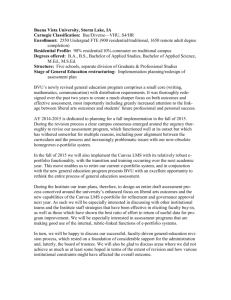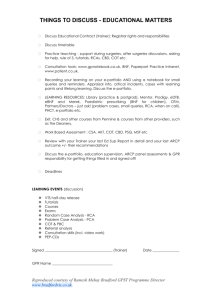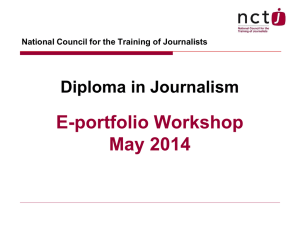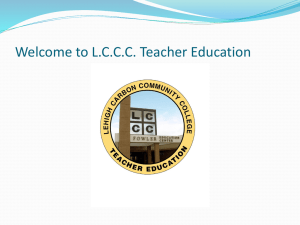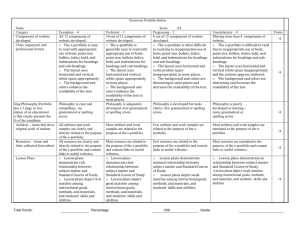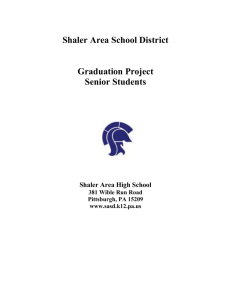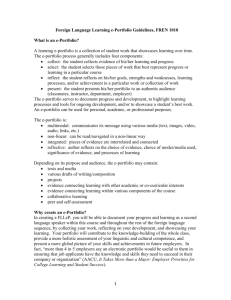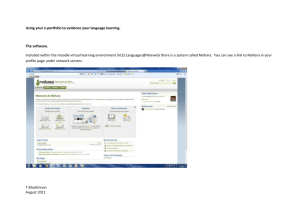the management aspect of the e-portfolio as an assessment tool
advertisement
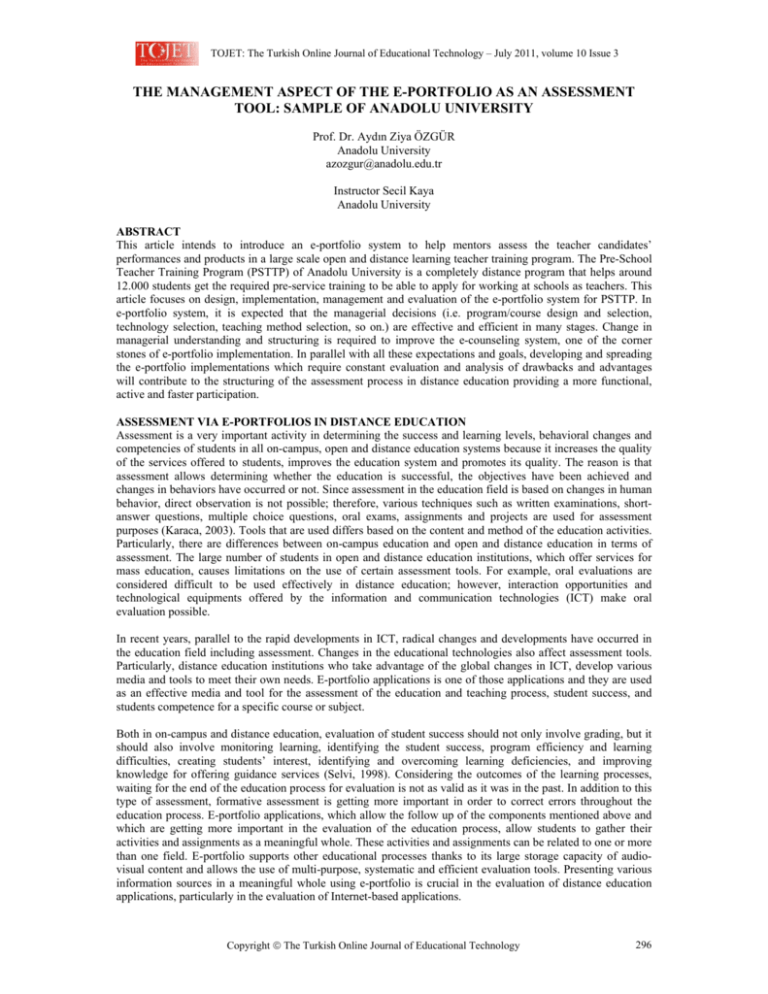
TOJET: The Turkish Online Journal of Educational Technology – July 2011, volume 10 Issue 3 THE MANAGEMENT ASPECT OF THE E-PORTFOLIO AS AN ASSESSMENT TOOL: SAMPLE OF ANADOLU UNIVERSITY Prof. Dr. Aydın Ziya ÖZGÜR Anadolu University azozgur@anadolu.edu.tr Instructor Secil Kaya Anadolu University ABSTRACT This article intends to introduce an e-portfolio system to help mentors assess the teacher candidates’ performances and products in a large scale open and distance learning teacher training program. The Pre-School Teacher Training Program (PSTTP) of Anadolu University is a completely distance program that helps around 12.000 students get the required pre-service training to be able to apply for working at schools as teachers. This article focuses on design, implementation, management and evaluation of the e-portfolio system for PSTTP. In e-portfolio system, it is expected that the managerial decisions (i.e. program/course design and selection, technology selection, teaching method selection, so on.) are effective and efficient in many stages. Change in managerial understanding and structuring is required to improve the e-counseling system, one of the corner stones of e-portfolio implementation. In parallel with all these expectations and goals, developing and spreading the e-portfolio implementations which require constant evaluation and analysis of drawbacks and advantages will contribute to the structuring of the assessment process in distance education providing a more functional, active and faster participation. ASSESSMENT VIA E-PORTFOLIOS IN DISTANCE EDUCATION Assessment is a very important activity in determining the success and learning levels, behavioral changes and competencies of students in all on-campus, open and distance education systems because it increases the quality of the services offered to students, improves the education system and promotes its quality. The reason is that assessment allows determining whether the education is successful, the objectives have been achieved and changes in behaviors have occurred or not. Since assessment in the education field is based on changes in human behavior, direct observation is not possible; therefore, various techniques such as written examinations, shortanswer questions, multiple choice questions, oral exams, assignments and projects are used for assessment purposes (Karaca, 2003). Tools that are used differs based on the content and method of the education activities. Particularly, there are differences between on-campus education and open and distance education in terms of assessment. The large number of students in open and distance education institutions, which offer services for mass education, causes limitations on the use of certain assessment tools. For example, oral evaluations are considered difficult to be used effectively in distance education; however, interaction opportunities and technological equipments offered by the information and communication technologies (ICT) make oral evaluation possible. In recent years, parallel to the rapid developments in ICT, radical changes and developments have occurred in the education field including assessment. Changes in the educational technologies also affect assessment tools. Particularly, distance education institutions who take advantage of the global changes in ICT, develop various media and tools to meet their own needs. E-portfolio applications is one of those applications and they are used as an effective media and tool for the assessment of the education and teaching process, student success, and students competence for a specific course or subject. Both in on-campus and distance education, evaluation of student success should not only involve grading, but it should also involve monitoring learning, identifying the student success, program efficiency and learning difficulties, creating students’ interest, identifying and overcoming learning deficiencies, and improving knowledge for offering guidance services (Selvi, 1998). Considering the outcomes of the learning processes, waiting for the end of the education process for evaluation is not as valid as it was in the past. In addition to this type of assessment, formative assessment is getting more important in order to correct errors throughout the education process. E-portfolio applications, which allow the follow up of the components mentioned above and which are getting more important in the evaluation of the education process, allow students to gather their activities and assignments as a meaningful whole. These activities and assignments can be related to one or more than one field. E-portfolio supports other educational processes thanks to its large storage capacity of audiovisual content and allows the use of multi-purpose, systematic and efficient evaluation tools. Presenting various information sources in a meaningful whole using e-portfolio is crucial in the evaluation of distance education applications, particularly in the evaluation of Internet-based applications. Copyright The Turkish Online Journal of Educational Technology 296 TOJET: The Turkish Online Journal of Educational Technology – July 2011, volume 10 Issue 3 E-portfolio, which is defined as a digital storage area where audio-visual content such as text, picture, video and voice is stored (Abrami & Barrett, 2005), is a method that also includes software tools that support educational process and evaluation activities in addition to organizing the content (Ahn, 2004; Galloway, 2001; Reinhartz & Beach, 1999; Rogers & Chow, 2000). E-portfolio, which must be seen as a process, is important because it allows the construction of knowledge and offers different opportunities and multimedia options to evaluate prior knowledge (Tuttle, 2007). Otherwise, providing and proving documents related to student achievement are some other important characteristics and opportunities of e-portfolios. E-PORTFOLIO AS AN ASSESSMENT TOOL AT ANADOLU UNIVERSITY Anadolu University Open and Distance Education System, which closely follows the developments in ICT, have been using the e-portfolio applications effectively since 2008 as an assessment system. Anadolu University Distance Education System has continuously increased the number of Bachelor’s degree, associate degree programs, and Bachelor’s degree completion programs, and adjusted them in the past 28 years in accordance with the developments in the Turkish Higher Education system. (Çekerol & Şenel, 2008). The number of students in the 2009-2010 academic year is 1,124,768. This number equals to 48% of the students in Turkish higher education. Anadolu University Distance Education System does not only meet the higher education demand in our country, but it also offers training to national education, health, theology, agriculture, police, gendarmerie, land, air and naval forces staff through distance education (AOF, 2009a). Open Education Faculty (OEF) Distance Education System, which takes advantage of the developments in ICT, is the pioneer of various applications in Turkey such as mobile applications, e-learning, synchronous facilitation service, and e-support. Also OEF increases the variety of the education media that it offers to its students. Each new application and technology causes innovations in assessment tools. E-portfolio, which is among the Internet-based evaluation methods, is seen as a new application at Anadolu University Open Education System. Since it is a first in Turkish higher education and in distance education, it reinforces the pioneer role of Anadolu University in educational applications. Taking advantage of e-portfolio in the evaluation of the education process is important when the number of students and the geographical distance between the institution and the students are considered. Those students can offer evidence of the activities they are involved in and reflect their experiences as the advantages of eportfolio. In addition, e-portfolio is seen as a solution to overcome problems such as the large number of distance education students and the limitations of time and human resources for evaluation. At Anadolu University Open and Distance Education System, e-portfolio applications have been used effectively in Pre-school teaching B.A program (PSTTP) since the 2008-2009 academic year. Pre-school teaching B.A program is a 4 year Bachelor’s degree program and is seen equal to the on-campus pre-school teaching Bachelor’s degree programs in Turkey. E-portfolio is used for the evaluation of the ‘School Experience’ course in the 3rd year, and ‘Teaching Implementation’ and ‘Community Service’ courses in the 4th year in Pre-school teaching B.A program. School Experience and Teaching Experience courses, which aim the teacher candidates to learn about the preschools, preschool education programs, daily educational activities, and preschool teaching profession, are based on observation, planning, implementation and evaluation. Another implementation course, “Community Service” course, has been developed so that teacher candidates can learn and gain basic skills about works that aim to serve the society. This course covers activities such as identifying the current problems of the society, preparing projects to solve them, joining academic activities such as panels, conferences, congress, symposiums, etc. as audience, speaker or organizer, and voluntary involvement in various social projects. This course aims to enable the preschool teacher candidates to serve the society by preparing and doing activities related to the problems (such as environment, education, health, woman health, child care, etc.) of the society in which they live. The expectation from this course is that teacher candidates will become more active and democratic individuals and more active in issues such as solidarity and cooperation, undertaking responsibilities, and creating projects and putting them into implementation. Briefly, they are expected to gain experience in becoming modern individuals. E-portfolio system, which is used for evaluating these courses, is considered to be used for training qualified teachers who know and use the most updated ICT through distance education programs. Training of teachers, who are the corner stones of the creation of an educated, modern and innovative society, is one of the most important fields on which universities should focus. “School Experience”, “Teaching Implementation” and “Community Service” courses are taught and evaluated through e-portfolio. Teacher candidates login the e-portfolio system using the user name and passwords given to them and load their activity reports to the portal every week regularly. Mentors and academic facilitators evaluate those activity reports and give feedback to the teacher candidates. Teacher candidates can revise their Copyright The Turkish Online Journal of Educational Technology 297 TOJET: The Turkish Online Journal of Educational Technology – July 2011, volume 10 Issue 3 reports based on the mentors’ and academic facilitators’ feedbacks and reload them to the portal in one week. The last loaded report is taken into consideration while grading the reports. In this way, to what extend the students take into account the suggestions and warnings of their mentors and academic facilitators and their efforts for the course is evaluated objectively. If the teacher candidate does not load an activity report till the end of the second week, she or he is considered absent for that week. Mentors and academic facilitators attach great importance to the preparation of original reports. (Özgür, et. al. 2009). Thanks to this application, teacher candidates can have synchronous and asynchronous interaction with their facilitators and they free themselves from the load caused by the photographs, handmade works, story cards, and CD-ROM materials that they add to their files in their activities. For the faculty, this application allows effective use of time and human resources, storing files in the file, and decreases the communication, transportation, management and time costs. In the 2009-2010 academic year, 674 mentor teachers and 40 academic facilitators served to 4,810 students in the implementation courses in 252 preschools in 81 cities. The number of active participants of the e-portfolio portal is 8,168 for 2009-2010. The e-portfolio applications at Anadolu University open and distance education system is important in that it is the first in Turkey in terms of the evaluation of teacher candidates trained through distance education and it will shed insight into the studies in this field. THE MANAGEMENT ASPECT OF THE E-PORTFOLIO The organization structure of the e-portfolio system, the parts involved in the management process, and the characteristics of the communication channels among the students are the major factor for a successful eportfolio application. Guo ve Greer (2005) emphasized that e-portfolios are not only learning and assessment activities; also they have positive effects among student-teacher and students-student communication and collaboration. Moreover, Özgür et. al. (2009) stated that e-portfolio applications not only improve collaboration between student-student and student-teacher, at the same time they improve co-operation among teachers as its employees. Additionally, researches stated that teachers develop different but positive attitudes toward the effective evaluation of teaching process with the use of e-portfolios (Heath 2002; Napper and Barrett, 2004; Klett, Wright and Kennedy, 2003; Wade, Abrami and Sclater, 2005). Benefiting from all these advantages is only possible through determining how to perform the assessment activities, and how to publish them on the portal in parallel with the goal and vision of the institution. Departing from this approach in planning and realizing the e-portfolio application, Anadolu University first shaped the management aspect of the application in line with its vision and goals. In the scope of the Open Education Faculty Pre-school Teaching BA Program (PSTTP) application courses carried out in cooperation between Anadolu University Rectorship and Ministry of Education. Anadolu University is represented by PSTTP Implementation and Academic Coordinatorship while Ministry of Education is represented by Provincial Coordinators, School Coordinators and Mentor teachers. It is essential that faculty coordinators, school coordinators and mentor teachers work in close cooperation in evaluating PSTTP implementation activities with traditional methods. Moreover, the teacher candidate should perform his duties and responsibilities in cooperation with his mentor teacher. The relationships between the individuals involved in the traditional implementation process are given below in Figure 1. Copyright The Turkish Online Journal of Educational Technology 298 TOJET: The Turkish Online Journal of Educational Technology – July 2011, volume 10 Issue 3 Figure 1. The Diagram for the Traditional Process of OEF PSTTP Implementation Courses A similar structure was set for the e-portfolio implementation within the scope of PSTTP implementation lessons. When the steps followed for transporting the portfolios to the OEF Coordinatorship were abolished, the problems faced by Provincial Implementation Coordinators, School Implementation Coordinators and OEF offices were removed. In terms of management, this change in the cooperation between Anadolu University and Ministry of Education has affected management, communication and education dimensions. OEF implementation Coordinatorship, mentor teachers and academic facilitators actively take part in the implementation of e-portfolio. In this respect, OEF Coordinatorship is responsible for the organization of the implementation courses and the management of the e-portfolio system. The mentor teacher has to: • plan the activities that the teacher candidate will perform on the e-portfolio portal, • mentor the teacher candidates both in classroom and on the Internet, • evaluate the studies of the teacher candidates weekly, and • transfer the results of evaluation to the OEF Coordinatorship through the portal. Academic facilitators represent the faculty for the guidance and counseling service. In this respect, they have to: • evaluate the studies of the teacher candidates weekly, and • transfer the results of evaluation to the OEF Coordinatorship through the portal. Figure 2 shows the current organizational/hierarchical structure for the implementation courses performed with e-portfolio and the communication and interaction channels between the individuals involved in the management of the e-portfolio system. Copyright The Turkish Online Journal of Educational Technology 299 TOJET: The Turkish Online Journal of Educational Technology – July 2011, volume 10 Issue 3 Rector of Anadolu University Ministry Of Education Provincial Coordinator OEF Deanery Pre-School Coordinator Academic Coordinator PSTTP Coordinatorship (E-portfolio System) Mentor Teachers Academic Facilitators Teacher Candidates Figure 2. Organizational Structure for E-Portfolio System The communication and interaction relations defined with lashes in Figure 2 are complex processes which require very good planning in terms of management. Synchronous and asynchronous interactive communication environments provides fast, effective and economic service to the teacher candidates, and offers individual support opportunity for them to cope with the isolation feeling usually encountered in distance education systems. Teacher candidates can directly contact with PSTTP Coordinatorship, mentor teachers and academic facilitators in the e-portfolio implementation. The implementation of academic consultancy not available in the traditional style is effective in removing the isolation feeling of the teacher candidates and enriching the consultancy services for professional development. A student-centered structure was targeted in the communication dimension of the e-portfolio implementation, and student-student, student-mentor teacher, student-academic facilitator and student-institution interaction were included on the portal. OEF Implementation Coordinatorship is responsible for providing coordination between all the institutions and individuals involved in the implementation courses, and it is in the junction point of all the communication channels. The control and management of the processes between the parties with a communication channel and the coordination between the parties without a communication channel are realized by OEF Coordinatorship. In the e-portfolio implementation process OEF Pre-school Teacher Training Program Academic and Implementation Coordinatorships, Distance Education Department and Computer-Aided Education (CAE) Unit have taken roles. OEF PSTTP Coordinatorships and Distance Education Department were concerned with the education design and content development process of the project while CAE Unit was concerned with the technologic design and application. The stages followed within the scope of design and applications are as follows: • A Portal was designed using Microsoft Office Sharepoint Server software. • The duties and responsibilities of the institutions and individuals involved were defined, and published on the portal. Copyright The Turkish Online Journal of Educational Technology 300 TOJET: The Turkish Online Journal of Educational Technology – July 2011, volume 10 Issue 3 • The academic studies on teacher training and pre-school education were reviewed for the e-library and published on the portal. • PSTTP Teaching and Exam Regulation was prepared and published on the portal. • The handbooks on the operation of this implementation were published on the portal. • The link of Turkish Language Society was presented on the portal in order to help teacher candidates use Turkish language properly when preparing their activity reports. • The list of students were prepared and published on the portal. • Assessment Center Handbook was prepared and published on the portal. • The Assessment Center was designed in two separate parts: one for mentor teachers, the other for academic facilitators. • The questionnaires prepared to evaluate the effectiveness of the portal and get the views of the participants were given as a link on the portal. • Discussion Board was designed to enable student-student interaction and communication. Five categories were set to avoid confusion and repetition in the messages. These categories are: (1) Subjects related to activity reports, (2) Technical problems, (3) Suggestions for the system, (4) PSTTP General Issues, and (5) Extracurricular activities. The procedures followed by the PSTTP Implementation Coordinatorship to carry out the activities through the portal are listed as follows: • The need for mentor teachers in each city is determined considering the numbers of students in 81 cities all over Turkey. The need for the mentor teachers is sent to Provincial Coordinators who supervise the implementations in cities. • The Provincial Coordinators are invited to Eskişehir, and information and education activities are held to promote cooperation. • The kindergartens and mentor teachers are determined for each student in line with the kindergarten and mentor teacher lists submitted by Provincial Coordinators. The residence addresses of the students are taken into consideration for determining the practice schools and mentor teachers. The results are announced on the internet, and sent to the post addresses of the students. • User names and passwords are formed for the mentor teachers, academic facilitators and teacher candidates. The user names and passwords of teacher candidates are sent to their residence addresses while those of mentor teachers are sent to Provincial Coordinators to submit them. • The academic facilitators are trained on the use of Portal designed with Microsoft Office Sharepoint Server software and the assessment process. • The users are defined, their website access permissions are provided, and all the users are given the opportunity to roam on the site within the limits of their access permission. Mentor teachers and academic facilitators are authorized and the technical arrangements are done for them to reach the individual pages of the teacher candidates. • Technical and educational supports are given for those who encounter e-portfolio implementation for the first time. The individual pages of each teacher candidate are checked to fix the problems faced during uploading the activity reports to the portal. • The messages posted on the discussion board are checked and answered daily. The “Frequently Asked Questions” section which serves as a brief summary of the messages posted on the discussion board is updated regularly. • A handbook is prepared for the assessment and grading processes and this handbook is provided to the mentor teachers and academic facilitators. • Assessment section is activated during midterm exams and final exam to enter the grades of the teacher candidates. • Guidance visits are paid to the cities with dense teacher candidate population during midterm exams and final exam. The Provincial Coordinator is contacted, and meetings are organized for teacher candidates, mentor teachers and academic facilitators in these cities. As a result of the meetings held, any possible problem is identified, and opinions and suggestions are proposed. These guidance visits are quite important for improving the implementations. • The grades entered to the portal by the mentor teachers and academic facilitators are checked. If there is any striking difference between the grade of the mentor teacher and academic facilitator, “Assessment Commission” formed by the Coordinatorships examines their personal study fields and reports. • The grade of a teacher candidate is determined by taking the average of mentor teacher’s grade and academic facilitator’s grade. • The academic records of the teacher candidates are sent to Computer Center (BAUM) and the results are announced on the internet. Copyright The Turkish Online Journal of Educational Technology 301 TOJET: The Turkish Online Journal of Educational Technology – July 2011, volume 10 Issue 3 As a conclusion, the management of distance education equals to the control of various processes such as planning, design, production, assessment, access and maintenance. It is necessary to introduce the human resources, processes, and system outcomes/products clearly in order to manage the implementations effectively and successfully. Departing from the viewpoint of Khan (2001, p.106) on distance education in two stages as content development, logistics and support, the human resources, processes and products in the e-portfolio implementation can be expressed as in Figure 3. HUMAN RESOURCES PROCESSES Planning Planning Team PSTTP Coordinatorship Academic Coordinator Making need analyses, putting forward the objective, justification and Design Team Design PRODUCTS Project Plan Scenario and Outlines Computer Based Education Unit Portal Design E-portfolyo portal taslağı Production and Development Team Production and Development Materials PSTTP Coordinatorship Computer Based Education Unit Control and Corrections Application and Evaluation Team Application and Evaluation PSTTP Coordinatorship Mentor Teachers Academic Facilitatrors The installation and controls of the reports, grading E-portfolio Portal Process Outputs Reports Questions & Answers Feedback and Grades CONTENT DEVELOPMENT Transportation & Support Team PSTTP Coordinatorship Computer Based Education Unit Transportation & Support Ensuring coordination between people and institutions Educational and technical TRANSPORT & SUPPORT Figure 3. Human Resources, Processes and Products in the E-Portfolio System CONCLUSION According to the first assessment reports prepared on the e-portfolio implementation, which is used as a means to enhance the knowledge of the teachers, at the end of 2008-2009 academic year, the teachers and students report that this system has brought dynamism, order, plan and interaction to their studies. In this respect, it is obvious that e-portfolio implementation continues successfully and with the positive views of the parties. Therefore, it is aimed to make the use of e-portfolio implementation more common, develop and better this implementation in the light of the system participants’ (i.e. teacher candidates, mentor teachers, academic facilitators, support team, coordinators, and so on) opinions, suggestions and criticisms. In distance education implementations which will be shaped in line with the decisions taken, it is essential to determine the decision makers appropriately, and make the plans systematically within the decisions. In other words, a managerial process which covers planning to realize the management policies, relating the activities to the institutional mission and vision, and evaluating them is experienced in distance education institutions. During this process, it is expected that the managerial decisions (i.e. program/course design and selection, technology Copyright The Turkish Online Journal of Educational Technology 302 TOJET: The Turkish Online Journal of Educational Technology – July 2011, volume 10 Issue 3 selection, teaching method selection, so on.) are effective and efficient in many stages. Today’s distance education institutions require technology-based distribution systems which do not necessitate traditional academic structuring and complex programs and implementations development support systems. In other words, cooperation of experts from different disciplines, in this case a different structuring, is required to create a high quality distance education system. It is the same for the e-portfolio practice which stands among the distance education implementations. Especially, change in managerial understanding and structuring is required to improve the e-counseling system, one of the corner stones of e-portfolio implementation. In parallel with all these expectations and goals, developing and spreading the e-portfolio implementations which require constant evaluation and analysis of drawbacks and advantages will contribute to the structuring of the assessment process in distance education providing a more functional, active and faster participation. REFERENCES Abrami, P. & Barrett, H. (2005). Directions for Research and Development on Electronic Portfolios. Canadian Journal of Learning and Technology, 31(3), Web:http://www.cjlt.ca/content/vol31.3/abrami.html (Date:28.12.2010) Açıköğretim Fakültesi, (2009). Açıköğretim Sisteminin Tanıtımı. Web:http://www.anadolu.edu.tr/aos/aos_tanitim/aos.aspx (Date:12.12.2010) Ahn, J. (2004). Electronic Portfolios: Blending Technology, Accountability & Assessment. T.H.E. Journal, 31(1), 12-18. (EJ708092) Web:http://thejournal.com/articles/16706 (Date:17.11.2010) Çekerol, K. & Şenel, H.G. (2008). Açıköğretime Kayıt ve İnternet. 8th International Educational Technology Conference (IETC 2008-May), Eskişehir, Türkiye. Galloway, J. (2001). Electronic Portfolios (EP): A “How To” Guide. In C. Crawford et al. (Eds.), Proceedings of Society for Information Technology and Teacher Education International Conference, pp. 582-587. Chesapeake, VA: AACE. Guo, Z., & Greer, J. (2005). Connecting E-Portfolios and Learner Models. In G. Richards (Ed.), Proceedings of World Conference on E-Learning in Corporate, Government, Healthcare, and Higher Education, pp. 2075-2080. Chesapeake, VA: AACE. Heath, M. (2002). Electronic Portfolios for Reflective Self-Assessment. Teacher Librarian, 30(1), 19-23. Karaca, E. (2003). Öğretimde Öğrenci Başarısının Değerlendirilmesi. Anadolu Üniversitesi Eğitim Fakültesi Dergisi 3(2), 129-140 Khan, Badrul H. (2001). A Framework For Web-Based Learning. (Ed: Badrul H. Khan: Web-Based Learning). Educational Technology Publications, Inc., Englewood Cliffs , New Jersey Klett, M., Wright, V., & Kennedy, T. (2003). Electronic Portfolios: A Tale of Two Institutions' Experiences and Reflections. In C. Crawford et al. (Eds.), Proceedings of Society for Information Technology and Teacher Education International Conference, pp.2267-2268. Chesapeake, VA: AACE. Napper, V. & Barrett, H. (2004). Assessment and E-Folios Issues. In C. Crawford et al. (Eds.), Proceedings of Society for Information Technology and Teacher Education International Conference, pp. 39-40. Chesapeake, VA: AACE. Reinhartz, J. & Beach, D. (1999). Electronic Portfolios in Science for Professional Development and Student Assessment. In Proceedings of International Conference on Mathematics / Science Education and Technology, pp. 455-456. AACE. Rogers, G. M. & Chow, T. (2000). Electronic Portfolios and the Assessment of Student Learning. Assessment Update, 12(1), 4-6. Selvi, K. (1998). Üniversitelerde Uygulanan Başarı Değerlendirme Yaklaşımları. Kurgu Dergisi 15, 336-345 Ozgur, A. Z., Kaya, S. ve Diğerleri (2009). Anadolu Üniversitesi Açıköğretim Fakültesi Okulöncesi Öğretmenliği Lisans Programı Okulöncesi Eğitimde Uygulama Dersinde Eportfolyo Yönteminin Uygulanabilirliği. Anadolu Üniversitesi Bilimsel Araştırma Projeleri Proje No: 07073, Eskişehir Tuttle, H.G. (2007). Digital-Age Assessment: E-Portfolios Are The Wave Of The Future. Technology & Learning, 27(7), 22. Wade, A., Abramı, P.C., & Whıte, B. (2006). Using Electronic Portfolios To Help Students Become SelfRegulated Learners. The Canadian Resource for School-Based Leadership, 14(2), 23-25. Copyright The Turkish Online Journal of Educational Technology 303
